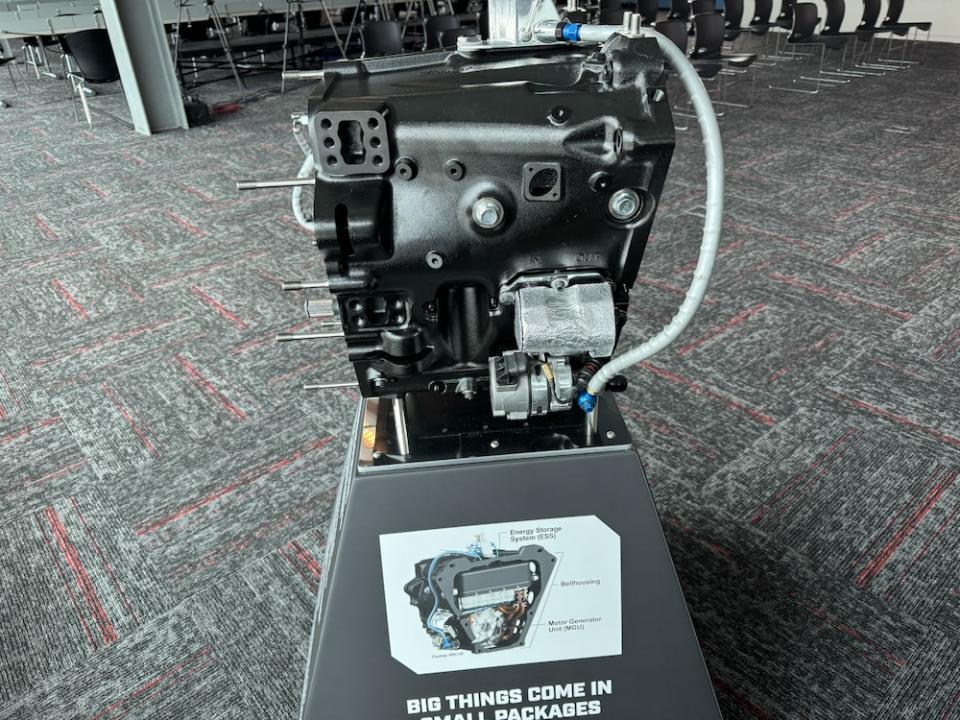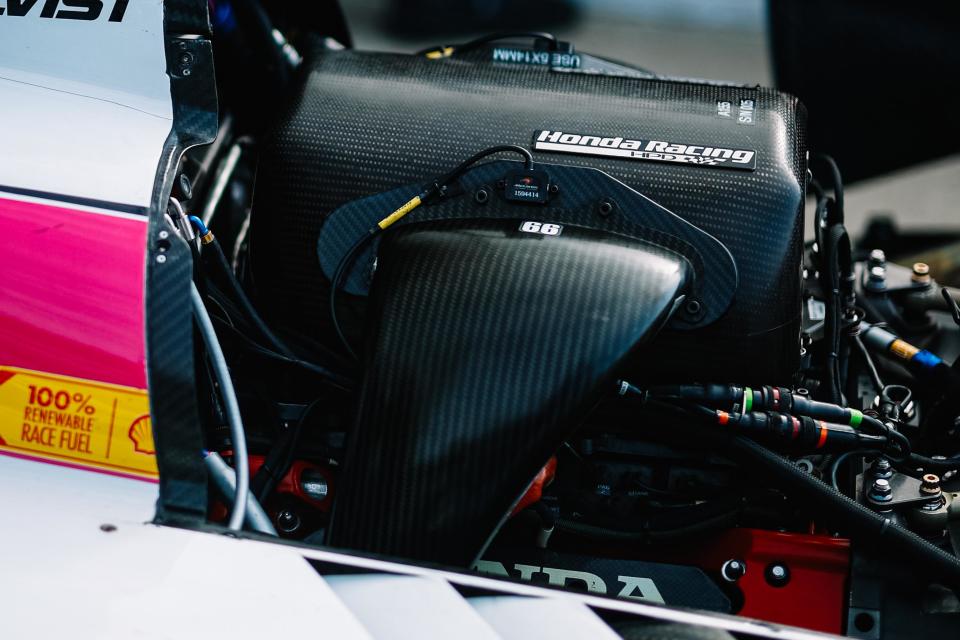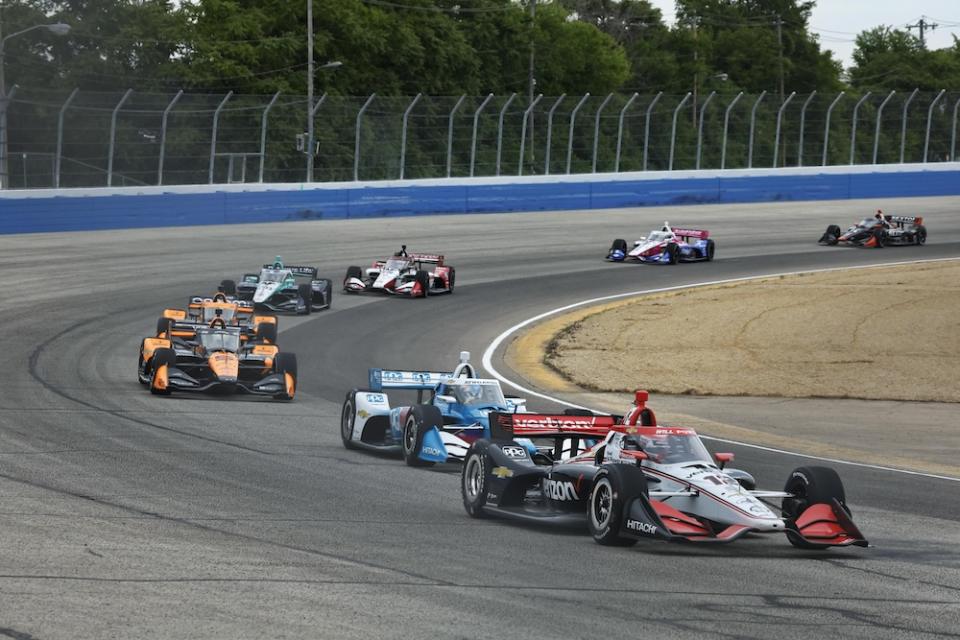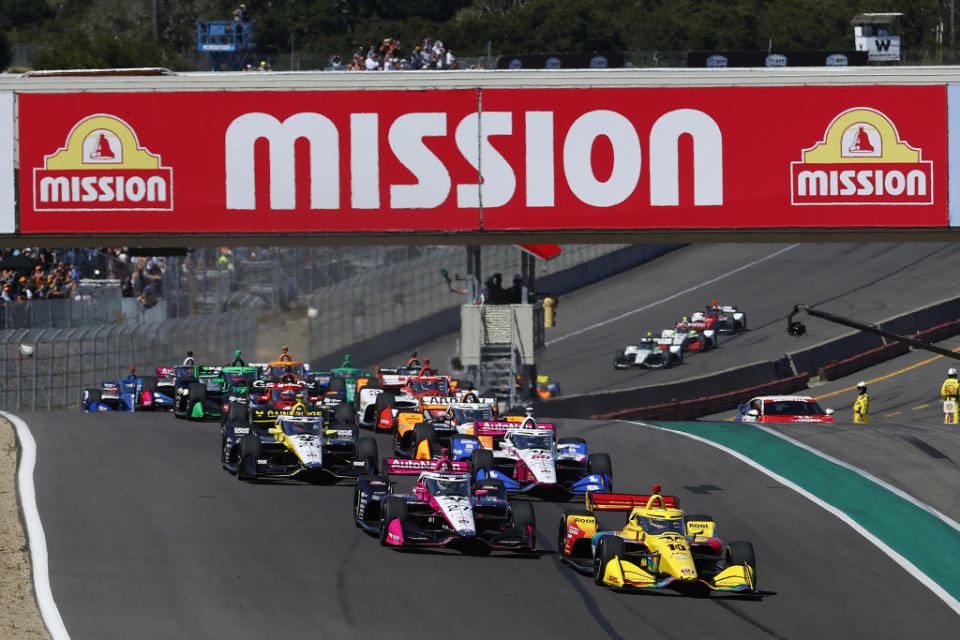RACER’s inside look at IndyCar going hybrid, part 1
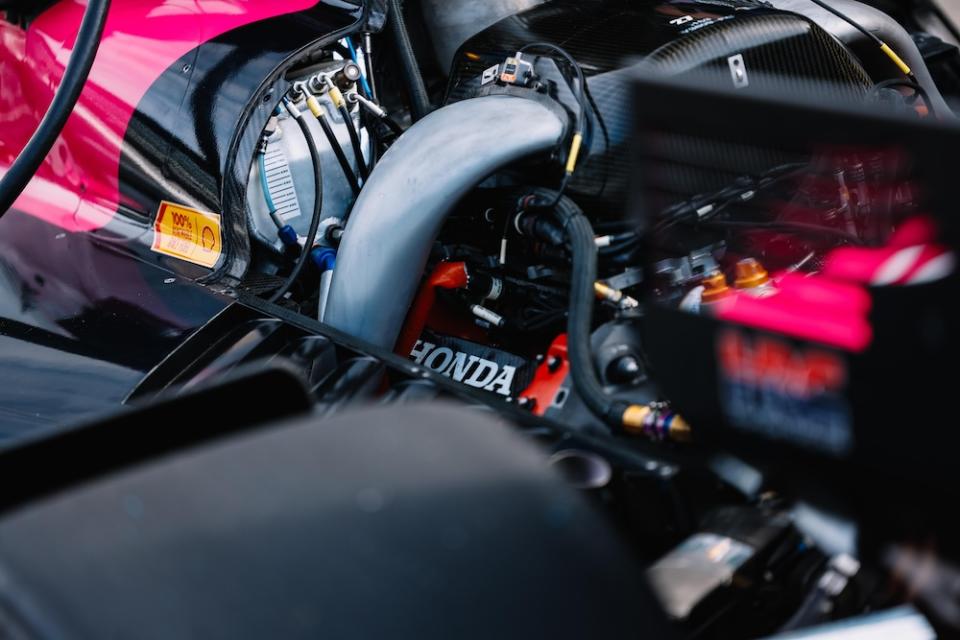
The NTT IndyCar Series’ midseason shift to hybrid electric powertrains is its biggest technological change since it introduced turbocharged V6 engines in 2012. There’s a lot to try and understand in the changeover, so I’ve tried to come up with as many questions and answers as possible to help in the process.
With upwards of 50 Q&A topics to cover, we’ll break them into a multi-part feature starting with some of the background and basics and follow with one or more installments that just might be of use if you’re interested in IndyCar’s new hybrid direction.
WHAT’S THE HISTORY? HOW LONG DID IT TAKE TO GET HERE WITH INDYCAR GOING HYBRID?
The abridged version of the story starts with the announcement about going hybrid being made on Aug. 1, 2019. COVID delivered some huge setbacks in 2020 and 2021, and again in 2022 — often of the supply chain variety — but the series’ original vendor for the project also dropped the ball, which brought the initiative back to zero and forced a complete reboot.
Late in 2022, longstanding IndyCar engine suppliers Chevy and Honda took over the project to keep it from failing. To do so, they made big financial and personnel investments by rerouting their new 2.4-liter IndyCar engine development budgets to fund the project. And in doing so, they saved the hybridization initiative and got the project to a place where a heavily revised energy recovery system (ERS) concept was testing late in the summer of 2023.
Some new ERS issues emerged towards the end of the year, so the plan to go hybrid at the start of the 2024 season was pushed back. More testing followed with a “final spec” version of the technology that would allow IndyCar to become hybrid, and with newfound confidence that everything was on the right track, the series declared in May that it would cross the hybrid threshold in competition at this weekend’s July 5-7 race at Mid-Ohio.
It will end up being a long gestation period — four years, 11 months, and six days — from the project receiving the public green light to seeing the green flag wave over the field of hybrids on Sunday at the Honda Indy 200, but it’s finally happening through the resilience, expenditures, and sacrifice of some great people and companies.
SO, WHAT’S THE THING CALLED? DOES IT HAVE A NAME?
IndyCar’s new ERS does not have a custom name. But while we were chatting at the Speedway in May, IndyCar communications VP Dave Furst nicknamed it “Harry the Hybrid,” which I loved, so that’s what I’m going with: Harry the Hybrid.
Harry the Hybrid.
IT’S ALSO BEING CALLED A “HYBRID SYSTEM” AND A “HYBRID UNIT”?
Yes. There’s the ICE and the ERS, and together, they become a hybrid powertrain, but there’s no such thing as a “hybrid system” or “hybrid unit.” Here, hybrid just means two different types of motors working together.
Even so, lots of people in racing just refer to the whole thing as a “hybrid system” or whatever because it’s easier than saying “energy recovery system” or “ERS,” I guess.
So…just go with hybrid system or hybrid unit. (And forgive me in the coming days when I give up and go with it as well.)
THE ERS IS NEW. WHAT ABOUT THE ICE?
Nope. The ERS is indeed brand-new, but the ICE is the same 2.2-liter twin-turbo V6 formula IndyCar has kept since 2012.
The ICEs Chevy and Honda just used in the cars at the June 23 race at Laguna Seca are the same for this weekend in Mid-Ohio and for years to come. Only the ERS side is new and being added to the cars.
WHO MAKES IT?
If we stick to the main items of interest in the package, it’s Chevrolet and Ilmor Engineering and Empel responsible for one half, Honda and Honda Racing Corporation US and Skeleton and BrightLoop for the other, plus Dallara, with IndyCar’s technical team overseeing all aspects of the ERS and setting the hybrid regulations.
All the new hybrid components have been been incorporated into the cars alongside the existing V6 engines. Joe Skibinski/IMS Photo
WHAT ARE THE MAIN COMPONENTS IN THE ERS PACKAGE?
There’s an electric motor, the motor generator unit — the MGU — that connects to the ICE and the transmission and spins up to 13,000 rpm. The MGU both charges an energy bank and takes the energy back and helps to accelerate the car. It’s made by Empel under the direction of Chevy and Ilmor.
Its ERS partner is the energy storage system — the ESS — which receives, holds and returns the electrical energy the MGU makes. HRC US assembles the ESS using 20 supercapacitors supplied in each unit by Skeleton.
As part of the ESS package, BrightLoop makes the DC-DC converter, which is a small device that regulates voltage.
The DW12’s pre-existing engine control unit (ECU), the McLaren-TAG 400i that runs the turbo V6s, has also been tasked with controlling all aspects of how the ERS units function and perform.
The last significant item in the loop is the steering wheel, which is custom to each driver, and has levers and buttons the drivers use to instruct the ERS to capture energy or turn that energy into horsepower and torque.
The MGU is set to give drivers an extra 60 hp and 33.2 lb-ft of torque to go with the 700-plus hp the ICEs offer. The ESS can hold a maximum of 320 kilojoules, which is a measurement of energy. The ESS is set to have a maximum output of 60 volts and 2000 amps.
WHERE DOES ALL OF THIS STUFF LIVE IN THE CARS?
Inside the bellhousing, which acts as a structural bridge that connects the back of the car — the transmission, rear suspension, and rear wing — to the rear of the Chevy and Honda engines.
HOW DID IT END UP THERE?
Back when the DW12s and 2.2-liter V6s were new in 2012, IndyCar gave its ICE suppliers the option of using one big turbo or two smaller turbos. For those who chose the twin-turbo arrangement, those turbos were (and continue to be) placed to the left and right of the engines at the rear of the sidepods. For those who went with the one large turbo, it was placed behind the engine in a space created within the bellhousing.
Only Honda used the single-turbo solution, and when the twin-turbo layout proved to be the better choice, IndyCar deleted the one-turbo choice starting in 2014 and made twin-turbos the new spec. That left some empty space between the engine and transmission where the single-turbo and its piping once lived.
Since IndyCar opted not to have a new car built that was designed to carry an ERS package from the outset, the leftover space in the bellhousing was identified as the only free area throughout the DW12 to try and fit an ERS into the chassis.
HOW DOES IT WORK?
The same way most ERS units work in other series: By charging some form of battery–also known as harvesting or regenerating — under braking or while accelerating, through the rear axles and then using that energy for propulsion.
The MGU contains a heavy metal cylinder that lives on the same input shaft that connects the engine’s crankshaft to the transmission. The MGU is a through-shaft design, so that drum is always spinning at the speed of the engine when the input shaft is connected to the ICE’s clutch and crankshaft.
Within the MGU, there’s all the usual windings and wirings and whatnot found in most electric motors, but here, when instructed, the MGU generates electricity — energy — with that spinning metal cylinder to charge the ESS.
With a good charge, the ESS can send the energy back to the MGU, which contributes mechanical force — rotating inertia — through the input shaft to help accelerate the car. That energy is held in the ESS and waits for the driver to decide when and where to use it, and when they do, it’s like a light switch being flipped to stack that ERS power and torque—adding up to 60hp and 33.2lb-ft—on top of what the turbo V6s is making.
After the harvesting event is complete, and drivers don’t have to take the ESS to a full charge every time the MGU is engaged, or deployment of that energy has happened, the MGU spins on the input shaft and is along for the ride while waiting for its next instruction to go to work. This also causes mechanical drag.
In the most basic of ways, the ERS works by having the MGU piggyback on the input shaft to spin and generate energy. And when it’s time to go, the MGU held the input shaft to spin harder than it would on its own from the V6 turbo alone, and that makes the gears in the transmission, and the axles connecting the transmission to the rear wheels and tires, go harder.
The hybrid systems will be employed differently on ovals, but can still have a significant impact on performance. Chris Jones/IMS Photo
THAT’S GREAT FOR ROADS AND STREETS WITH LOTS OF BRAKING, BUT HOW DOES THE ERS WORK ON OVALS WITHOUT BIG BRAKING OPPORTUNITIES?
This part’s pretty cool.
Drivers have the clutch levers behind the steering wheel to squeeze lightly if they want the MGU to harvest lightly, or they can squeeze hard if they want to MGU to harvest a bunch.
The clutch levers act like a brake pedal anytime they’re used (above 50ish mph), so if a driver wants to charge the ESS while running in the draft at Indy, they can keep their foot buried in the throttle and use soft squeezes of a clutch paddle to harvest and slightly slow the car to maintain the gap to whomever they’re drafting.
This concept was taken from some hybrid road cars that have little buttons to squeeze on the back of the steering wheel that tells the ERS to harvest/brake. In searching for a way to harvest on ovals, this option presented itself and was recognized as a perfect fit for IndyCar.
Before going hybrid on ovals, keeping that gap in the draft was done by lifting off the throttle, but now, the ERS can be utilized to add some mechanical drag by spinning up the MGU to harvest through steering wheel paddles, and in doing so, charge the ESS to have that ERS power to use as a push-to-pass device. Or, on the shorter and slower ovals, to do just as drivers might do on a road or street course and deploy that ERS power to get a better run out of a Turn 2 at Milwaukee or a Turn 4 at Iowa.
Outside of ovals, drivers can also use the clutch paddles to harvest on road and street courses and replicate a brush of the brakes or something more aggressive if they want to maintain full throttle.
Just as drivers use their fingertips on the steering wheel to shift gears and operate the clutch to leave the pits, the steering wheel is a new location to call for braking assistance by pulling on a clutch lever to engage the 5th brake, the MGU, and charge the ESS. It’s a really smart solution.
While it introduces new tactical elements inside the cockpit, neither the drivers nor the fans will be able to hear the hybrids kicking in. Perry Nelson/Motorsport Images
WILL THE CARS SOUND DIFFERENT?
That’s been the biggest fear since this was announced, and the answer is easy: No. Negative. Not at all.
There’s nothing about the ERS units that takes away from the internal combustion engines. The same 2.2-liter twin-turbo V6 motors from Chevy and Honda that you’ve heard revving to 12,000 rpm are 100 percent unchanged going into Mid-Ohio.
They sound exactly the same way they did before the ERS units were added.
DO THE ERS UNITS MAKE NOISE LIKE YOU HEAR IN OTHER HYBRID OR FULL-ELECTRIC SERIES?
That’s another no. The former WEC LMP1 Hybrids had giant MGUs which made a loud mechanical whine when they were harvesting energy. Formula E’s cars also do a lot of whining. IndyCar’s ERS units do not.
In fact, you can’t hear them at all. That was a big revelation when I was at the Sebring hybrid test last August where only two cars were on track and there was almost total silence until Scott Dixon (testing for Honda) or Will Power (Chevy) came by on solo runs.
With no other sounds to drown out their cars, they’d come into view, brake hard going into a hairpin — which triggered the MGU to harvest — and all you could hear were their V6 motors howling. Same when they accelerated away and deployed the e-power through the MGU. No whine, no auditory signal that harvesting or deploying is going on. Pure exhaust sounds, only.
WHAT ABOUT INSIDE THE CARS?
I’ve only asked a few drivers so far, but they’ve said the same thing: They can’t hear the MGU working from inside the cockpit. “Honestly, I don’t hear it at all,” Andretti’s Marcus Ericsson told me at the recent Milwaukee hybrid test.
So, yes, the MGU is in there, and working. but if nobody told the world IndyCar had done hybrid, there would be no way to tell from listening to the cars go by.
WILL IT MAKE THE CARS FASTER?
At the tracks where no repaving has been done (that excludes the next two events at Mid-Ohio and Iowa), no, there’s no expectation for track records to be set by hybrid Indy cars in 2024.
There’s a lot of weight that comes with the new ERS units, and that won’t make the lap times better or cause lap speeds to go up. For example, at the last pre-hybrid race in Monterey, the minimum weight for all cars (minus driver, fuel, etc.) was 1685 lbs. Starting this weekend, the new minimum weight is 1785, an increase of 105 lbs. The former short oval minimum of 1670, like for Iowa next week, has also risen by 105 to 1775 lbs.
But if there’s a lot of power and torque added by the ERS in upcoming seasons, it could negate the weight increase and lower lap times or increase lap speeds.
But, to start, that 60hp/33.2lb-ft doesn’t fall into the category of “a lot,” so don’t be surprised if times and speeds aren’t as good as they were before going hybrid. It’s when IndyCar decides to dial up the ERS power and torque in 2025, hopefully, and once more in 2026, where the added weight could become a wash.
WHY IS INDYCAR GOING HYBRID? IT WAS JUST FINE WITHOUT IT, RIGHT?
Yes, and no. The racing itself has been great; no changes were necessary there. But the series was also at risk of becoming old timey and out of touch if it held onto being its non-hybrid self.
Without rehashing too many old topics, hybridization — having two or more different types of propulsion — has been around for decades in the automotive world (the first hybrid Toyota Prius model went on sale in 1997).
And since then, hybrids have gone from being weird cars that only a few manufacturers made and nobody wanted, to cars that are perfectly normal to see on the road, including fully-electric cars and trucks. Hybrids also represent a meaningful volume of sales and annual income today for a growing number of auto brands.
(That’s the end of your hybrid public service announcement.)
In our world, Formula 1 is hybrid. IMSA’s GTP cars are hybrid. The FIA WEC’s Hypercars are hybrid. The FIA World Rally Championship’s Rally 1 cars are hybrid. And then there’s Formula E and Extreme E that are all-electric. NASCAR isn’t hybrid, nor is the NHRA.
But the tide started turning towards hybrids or EVs in racing a while ago. If anything, IndyCar’s a late adopter of hybridization, but it needed to happen to stay relevant to the auto industry.
SOUNDS LIKE IT’S MORE OF A MARKETING THING THAN ANYTHING ELSE
It is. There’s no need to pretend that some new technological frontier is going to be explored by IndyCar going hybrid. Its custom ERS unit is quite cool, but it’s the packaging of the components that’s innovative. A supercapacitor-based ESS and a spinning-drum MGU is by no means new in racing.
But, there are plenty of marketing-related precedents for tech moves like this one in the sport.
Back in the 1980s, a lot of tire manufacturers started changing how they made their tires, going from bias-ply construction to radial construction. And so many of the road tire companies involved in racing started doing the same thing, changing their racing tires from bias-ply to radial, to race what they were selling. That’s what’s happening here with going hybrid.
Like updating those tires from an old technology to something newer, hybrids are a better match for what auto manufacturers are making and selling today and tomorrow.
(Sorry, that sounded like another public service announcement.)
Will Chevy or Honda learn something at the track with hybrids that will radically alter future generations of their road vehicles? Doubtful. Will racing with hybrids make it easier to promote their presence in IndyCar and point to the relevance between what they sell and what they race? Absolutely.
UP NEXT: How much do they cost, does the ERS replace the alternator, how will we know when they’re harvesting or deploying, can the cars start themselves, will the ERS prevent fuel-save races from happening, and more.

 Yahoo Autos
Yahoo Autos 